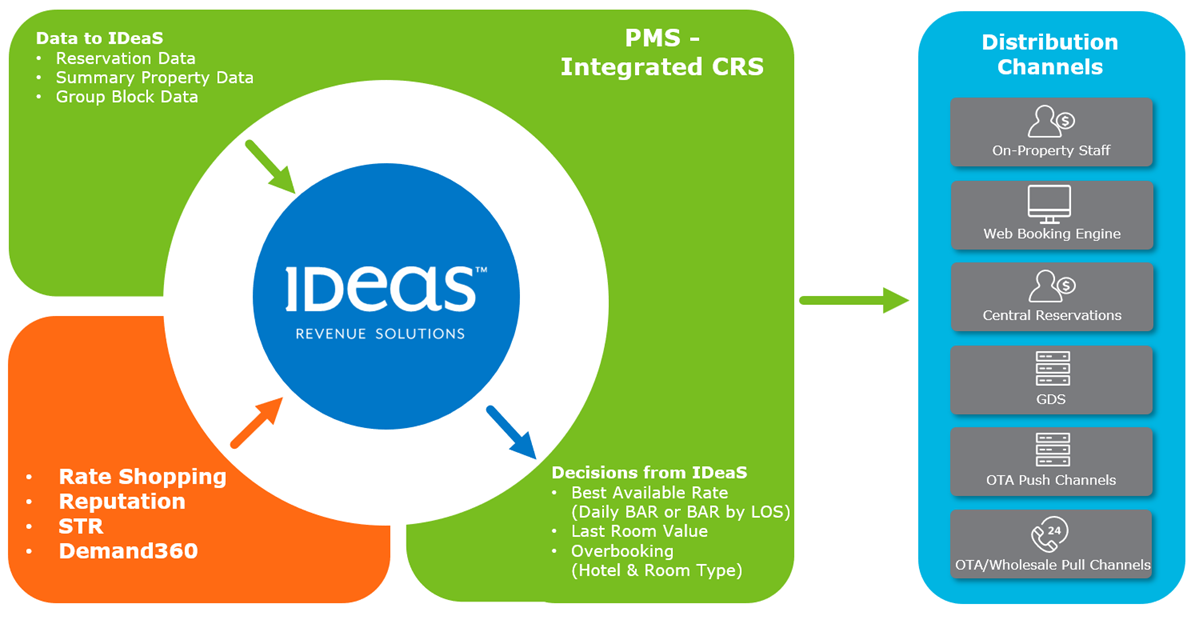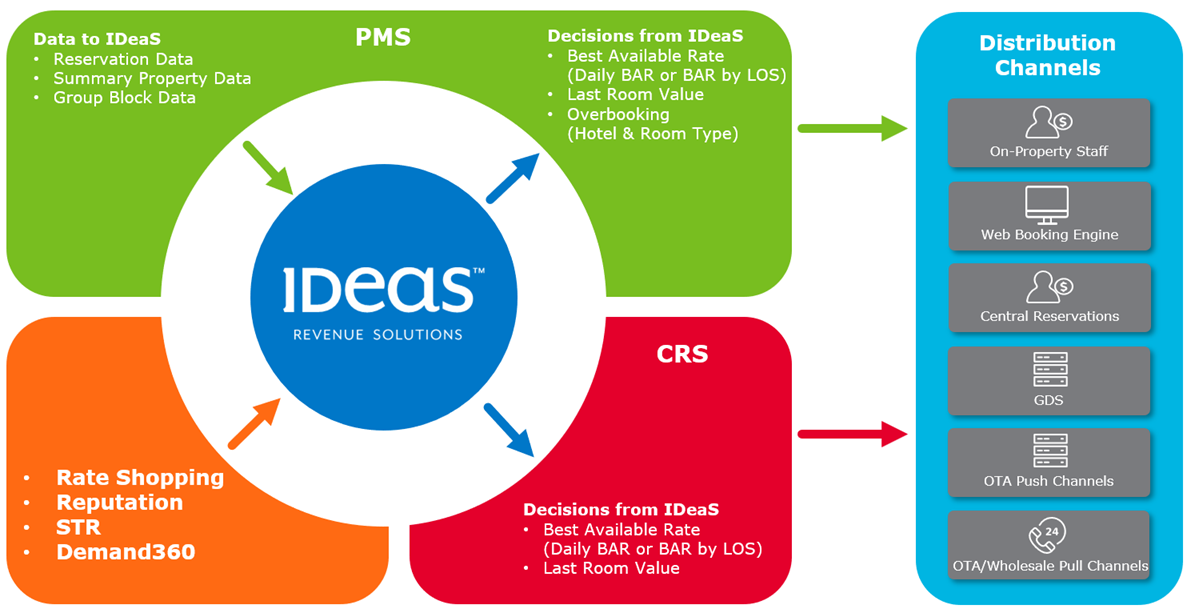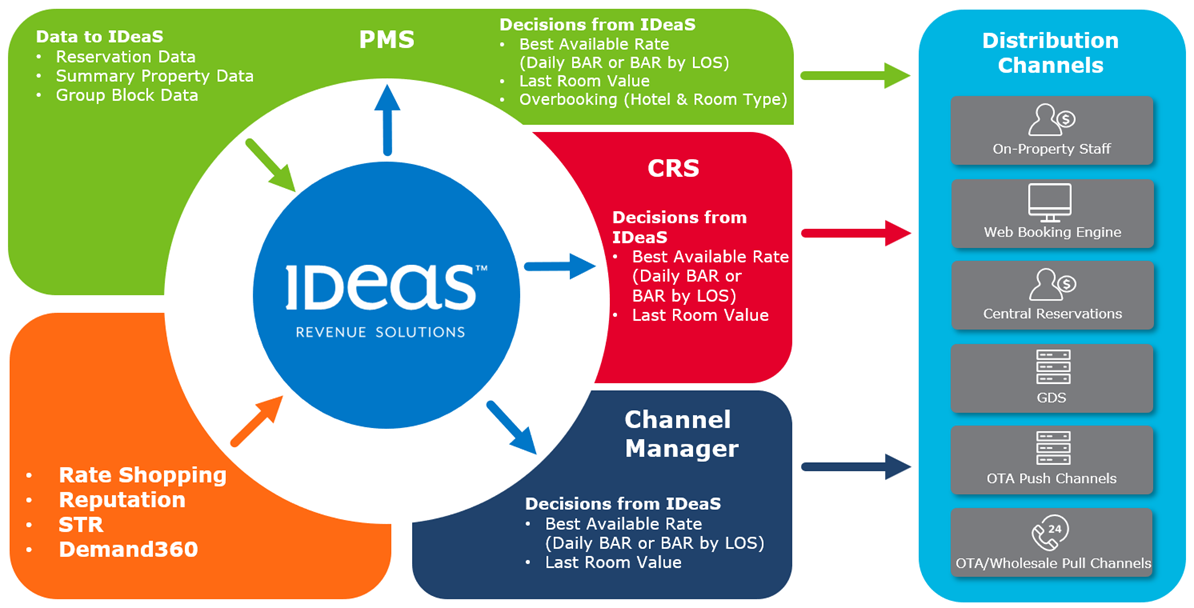Integration Questionnaire
The sooner you complete the Integration Questionnaire, the sooner G3 RMS is ready to maximize revenues for you. Using your answers, IDeaS sets up how G3 RMS receives and processes data from your Reservation System![]() The primary reservation system, like a PMS or CRS, that provides data to G3 RMS. The data from that one system is used by the RMS to forecast, optimize and produce controls. The controls are sent to all selling systems, which for some integrations may exclude the reservation system..
The primary reservation system, like a PMS or CRS, that provides data to G3 RMS. The data from that one system is used by the RMS to forecast, optimize and produce controls. The controls are sent to all selling systems, which for some integrations may exclude the reservation system..
To view examples of how G3 RMS exchanges data and decisions with other systems, see Integration Scenarios.
Steps to Use
Click ![]() , then External Data, and then Integration Questionnaire.
, then External Data, and then Integration Questionnaire.
Drafting Your Answers
As you work through the form, click Save As Draft, if you need to save it and complete it at a later time. The status of the form displays as "In Progress."
Completing Your Answers
When you complete the questions, click I'm Done. Doing so finalizes the form and sets the status to "Completed."
You cannot edit the form after you complete it.
Question Details
Refer to the following descriptions if you need more information about the questions:
General Questions
| Question | Description |
|---|---|
| Change from another reservation system |
|
| Version Number | Provide the version number of the reservation system (typically your PMS or CRS) that will provide data to G3 RMS. |
| Time Zone | Select the international time zone where the property is located. G3 RMS uses this time zone wherever it shows times. |
| Night Audit | Tell us what time your night audit is typically complete, so we can estimate when to expect business day end data. |
| Currency Codes |
|
| Historical Data | Slide the switch to green |
| Future Reservation Days | Enter the maximum number of days in the future for which guests at the property can make reservations. |
| Future Days to Forecast | Enter the number of future days for which you want G3 RMS to forecast demand for the property. This period becomes the property's Forecast Window. This value cannot be larger than your future reservation days. |
| Future Days for Decision Upload | Enter the number of future days for which you want G3 RMS to send decisions to your selling systems. This period becomes the property's Upload Window. This value cannot be longer than your Forecast Window. |
| Pseudo Room Type Codes | Select the property's room type codes that are pseudo room types, or non-guest rooms used for posting charges. G3 RMS removes these room types from the property's data, |
| Non-Yielded Room Type Codes | Select the property's room type codes that G3 RMS will not be managing. For example, an owner-occupied room type. |
| Past Room Type Changes | Describe all room type changes that the property made in the past two years. For example, the property was renovated and renamed or deactivated a room type and added a new room type. |
| Matching Room Types | Slide the switch to green |
| Matching Rate Codes | Slide the switch to green |
| Group Block Status Codes |
Select the group block codes that the property uses for each of the following statuses. IDeaS uses the information to map the Group Status Codes.
|
Inbound Specific Questions
For some Reservation Systems we need additional information. Depending on your system, you may not see the below section at all, or only some of the questions.
| Question | Description |
|---|---|
| Change from Opera Agent to OXI | Slide the switch to green |
| Tax Inclusive | Slide the switch to green |
| Tax percentage | Enter the tax percentage value for those rate codes that include tax. |
| Packages |
To produce the best possible forecasts and decisions, G3 RMS needs to know the net "room only" value of reservations. In other words, it needs to know if your rate codes include other revenues than room, for example parking or breakfast. For example, you have a Bed and Breakfast Package that you sell for 250. Of that 250, 50 is food and beverage (F&B) revenue. In that case we recommend that you use package codes in your reservation system. The package code defines that the package price of 250 includes 200 room revenue and 50 F&B revenue. Some properties don't break out the package values in the reservation system. Instead, they move the revenue to F&B after check out. In that case, G3 RMS assumes that 250 is all room revenue. And during optimization, if it compares the package to a "room only" rate code of 250, it incorrectly assumes that both have equal value. See Reservation and Business Practices for other ways how you can help G3 RMS produce the best possible results. |
| List of Packages | Enter all rate codes where the Opera Transaction Code equals "Room/Accomodation Revenue". This information helps us set up G3 RMS. For example, in the data extracts |
| Reservations without room type | Select the room type that G3 RMS should assign to reservations that are missing this information. Enter "null" and G3 RMS selects the room type that has the largest Available Capacity to Sell |
| Daily BAR Rate Code | Enter the name of the Daily BAR Rate Code that you use in Opera. That is the rate code that we will link to G3 RMS' BAR pricing decision. |
| Other connected systems | Enter the names of all systems that send data to, or receive data from Opera. This helps us ensure that G3 RMS receives all the data it needs to function optimally. |
| Extract delivery start | Pick the date when you expect your reservation system will send the first data extract to G3 RMS. This helps us plan the onboarding for your system. |
| Night audit completion time | The time you enter here defines the time when G3 RMS triggers a "System Not Up to Date" Alert in the Information Manager. |
Integration Scenarios
Following are a few examples of how data and decisions flow between G3 RMS and your systems. An inbound system![]() A system that sends data to G3 RMS. A PMS or CRS are examples of Inbound Systems. Some PMS and CRS are also Outbound Systems, which means they receive decisions from G3 RMS. has an arrow pointing to IDeaS. For an outbound system
A system that sends data to G3 RMS. A PMS or CRS are examples of Inbound Systems. Some PMS and CRS are also Outbound Systems, which means they receive decisions from G3 RMS. has an arrow pointing to IDeaS. For an outbound system![]() A system that receives data from G3 RMS, for example a selling system. Some outbound systems support a two-way transfer of information. That means they act as an outbound system receiving data and as an inbound system sending data to G3 RMS., the arrow points in the opposite direction.
A system that receives data from G3 RMS, for example a selling system. Some outbound systems support a two-way transfer of information. That means they act as an outbound system receiving data and as an inbound system sending data to G3 RMS., the arrow points in the opposite direction.
If you have questions about your specific integration, contact your IDeaS representative.
G3 RMS Uploads Decisions to one System

G3 RMS Uploads Decisions to two Systems

G3 RMS Uploads Decisions to three Systems
